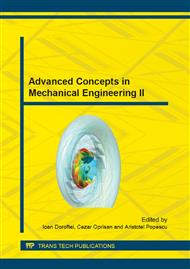p.133
p.139
p.145
p.151
p.157
p.163
p.171
p.177
p.183
Response Time to Sudden Changes in Speed and Load Regimes for Turbocharged Diesel Engine
Abstract:
The paper includes results from experimental determinations of parameters for turbocharged MB836Db diesel engine, which functioning at dynamic conditions. The studied functioning modes resulting from sudden changes in acceleration and/or loading. The authors used for experimental determinations an railway Diesel engine turbocharged, MB836Db. The results are obtained based on measurements made in the department of Thermal Systems and Environmental Engineering from University “Dunarea de Jos” of Galati. Authors used the equipment which contains PLC module CBM 500, which is put on the turbocharged MB836Db engine. Experimental measurements were performed for dynamic regimes (regimes varying in time) , in case of four changes for engine's acceleration and load.In conditions of acceleration (fast increase of rotation and/or load) only one part of exhaust gasses's energy is transformed in mechanical work for turbocompressor; the rest of the energy is used for the acceleration of different parts which are in rotation movement, to overcome the inertia of the turbocharger with free rotation. That is why, the pressure delivered by the turbocharger in case of functioning on unsteady conditions, at any moment is decreased than the supercharger pressure in steady working conditions, at the same speed and load regimes.The experimental results obtained for unsteady working conditions shows that the performances of engine and turbocompressor are reduced compared to the performances in stationary operating conditions, and this because the turbocompressor inertia is greater than the inertia of the injection system. Because of this issue is modified significantly the combustible mixture quality (decrease in the ratio of air and fuel ), which determines the increase of chemical pollution and decrease of engine performances.The authors presents some conclusions on the influence of the turbocharger’s response on the performances of engine in case of regimes varying in time, such as changes in acceleration and load.
Info:
Periodical:
Pages:
157-162
Citation:
Online since:
October 2014
Authors:
Price:
Сopyright:
© 2014 Trans Tech Publications Ltd. All Rights Reserved
Share:
Citation:


